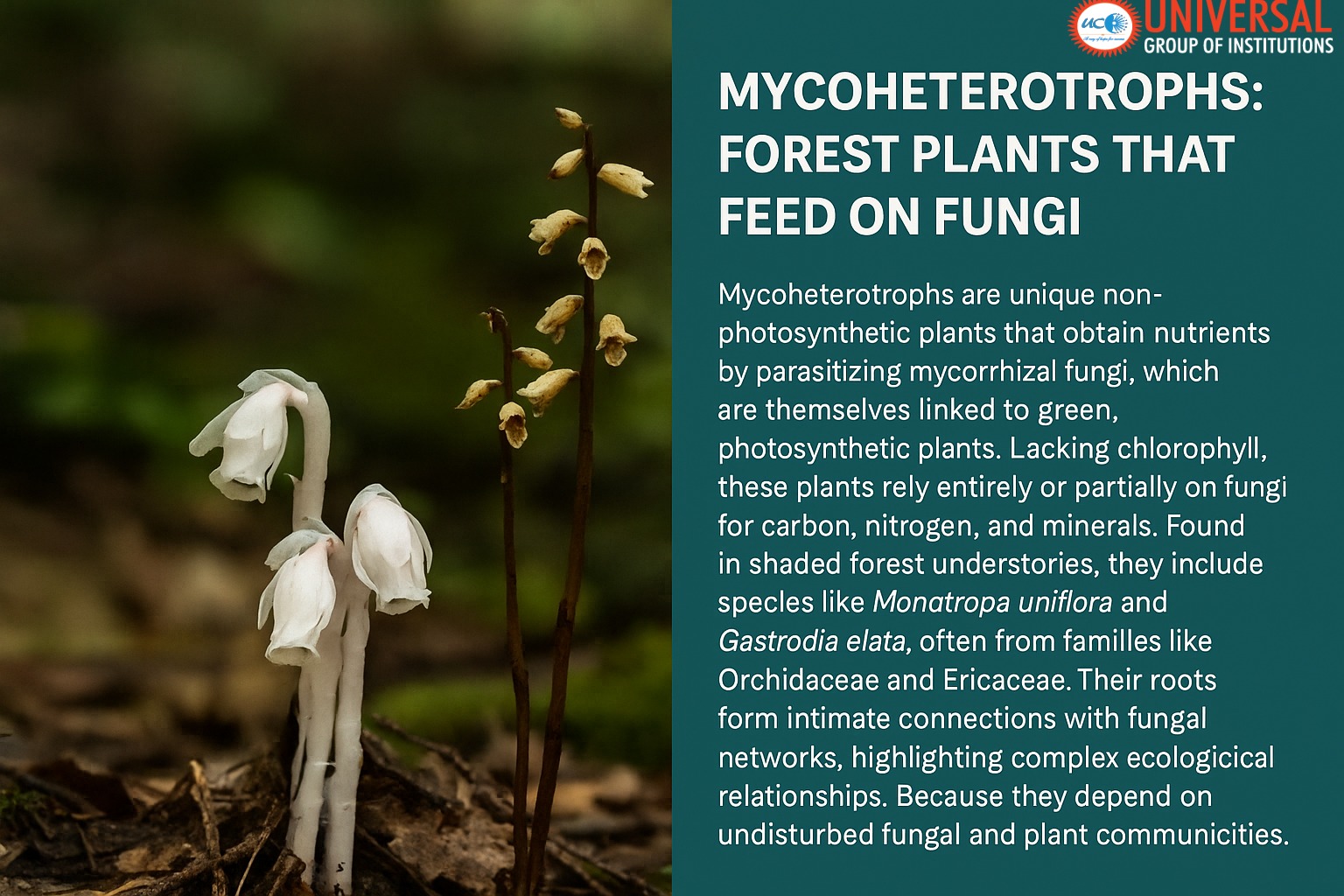Mycoheterotrophs: The Hidden Forest Plants That Feed on Fungi
Mycoheterotrophs: The Hidden Forest Plants That Feed on Fungi
In the intricate web of forest life, not all plants rely on sunlight for survival. Mycoheterotrophs are a remarkable group of non-photosynthetic plants that draw their nutrients from fungi rather than through photosynthesis. These plants have evolved to bypass the green chlorophyll-based energy system entirely—or at least partially—and instead tap into underground fungal networks that are themselves connected to photosynthetic host plants. From the dense forests of Big Lond to the temperate woodlands of North America, these fascinating organisms play a crucial role in ecosystem dynamics and contribute to the overall fungal diversity of forest ecosystems.
What Are Mycoheterotrophs?
The term mycoheterotrophy combines “myco” (fungus) and “heterotrophy” (obtaining nutrition from other organisms). These plants are either fully mycoheterotrophic, meaning they completely lack chlorophyll, or partially mycoheterotrophic, supplementing photosynthesis with fungal-derived nutrients. Unlike parasitic plants that attach to other plants directly, mycoheterotrophs parasitize fungi—specifically mycorrhizal fungi, which form mutualistic relationships with most vascular plants.
How Do They Survive?
Mycoheterotrophs establish specialized root structures that connect to the mycelium (the underground filaments) of fungi. These fungi, often ectomycorrhizal fungi, are engaged in mutualistic symbiosis with nearby green plants, exchanging soil nutrients for sugars derived from photosynthesis. Ectomycorrhiza, a type of symbiotic relationship between fungi and plant roots, plays a crucial role in this process. Mycoheterotrophs effectively hijack this fungal-plant network, absorbing carbon, nitrogen, phosphorus, and other minerals that were originally destined for the fungi’s green plant partners.
This tripartite relationship—host plant, fungus, and mycoheterotroph—reveals a fascinating ecological dependence that challenges the traditional plant-fungus symbiosis narrative and highlights the importance of fungal ecology in forest ecosystems.
Notable Examples in Nature
Mycoheterotrophs are most commonly found in dark, humid, and shaded forest understories, where light availability is low and photosynthesis is limited. Some of the most striking examples include:
- Monotropa uniflora (commonly known as the ghost plant or Indian pipe): A completely white, leafless plant native to temperate forests of North America and Asia.
- Gastrodia elata: A saprophytic orchid native to East Asia, used in traditional Chinese medicine for its medicinal properties and known for its unique subterranean life cycle.
- Corallorhiza spp.: Also known as coralroot orchids, found in temperate forest ecosystems and recognized by their coral-like underground structures.
These plants are often found in Orchidaceae (orchid family) and Ericaceae (heath family), which are known for their diverse and often mycorrhizal-dependent species. The presence of mycoheterotrophs contributes to overall plant diversity in forest ecosystems.
Ecological Importance and Conservation
The existence of mycoheterotrophs underscores the importance of fungal networks in forest ecology. They serve as indicators of healthy, undisturbed ecosystems, as their survival depends on the presence of mature trees, intact fungal communities, and proper soil structure. However, this specialization also makes them extremely vulnerable to habitat alteration, climate change, and forest fragmentation.
Because mycoheterotrophs rely on a stable and specific set of interactions, conservation of these plants necessitates a broader effort to protect forest ecosystems, including their ectomycorrhizal diversity—a component often overlooked in conservation strategies. Biodiversity conservation efforts must consider the intricate relationships between mycoheterotrophs, their host plants, and the associated ectomycorrhizal fungi.
Environmental stressors, such as pollution effects and atmospheric pollutants, can disrupt the delicate balance of these ecosystems. Sustainable forest management practices are crucial for maintaining the ecosystem resilience necessary for mycoheterotrophs to thrive, especially in the face of increasing forest fragments due to human activities.
Scientific and Educational Value
Beyond their ecological intrigue, mycoheterotrophs offer insights into evolutionary biology, particularly in the context of nutrient acquisition and symbiotic adaptation. Their existence challenges the long-standing definition of plants as photosynthetic organisms and opens up new avenues for mycorrhizal research, plant physiology, and conservation biology.
Studying mycoheterotrophs can provide valuable information about nutrient cycling in forest ecosystems and the role of fungi in supporting plant diversity. This knowledge can be applied to various fields, including the biotechnology industry and sustainable forestry practices. The field of fungi mycology has been greatly enriched by research on mycoheterotrophs, shedding light on the complex interactions between plants and fungi in forest ecosystems.
Fungi and Forest Ecosystems
The fungi associated with mycoheterotrophs, including various species of mushrooms and truffles, play a vital role in forest ecosystems. These ectomycorrhizal fungi contribute to soil structure, facilitate nutrient exchange between plants, and support wildlife food webs. For example, some species of truffles are an important food source for the northern flying squirrel in Douglas-fir forests of the Pacific Northwestern United States. The fungal diversity in these ecosystems is crucial for maintaining the delicate balance that supports mycoheterotrophs and other forest organisms.
However, fungal communities face threats from various sources. European fungal decline has been observed in recent decades, potentially due to factors such as acid rain, intensive forest management, and commercial harvesting of mushrooms. This decline could have far-reaching consequences for forest productivity and the survival of mycoheterotrophic species, particularly in fragmented forest habitats.
Conclusion
Mycoheterotrophs offer a compelling glimpse into the hidden relationships that sustain life beneath the forest floor. By tapping into fungal networks connected to green plants, they represent an evolutionary shortcut that rewrites our understanding of plant survival. Preserving these unique organisms means protecting not only the plants themselves but also the invisible mycorrhizal highways that nourish entire ecosystems.
As we continue to study these fascinating plants, we gain a deeper appreciation for the complexity of forest ecosystems and the importance of maintaining ectomycorrhizal diversity. By incorporating our knowledge of mycoheterotrophs into conservation strategies and forest management practices, we can work towards preserving these unique plants and the intricate web of life they represent, even in the face of increasing forest fragmentation and environmental challenges.






